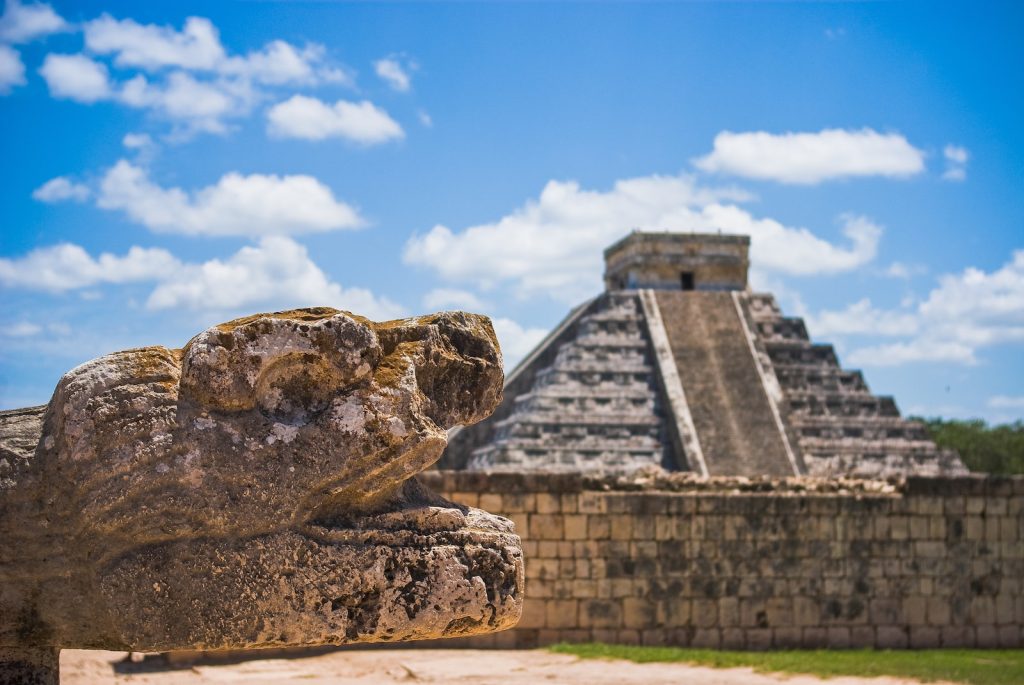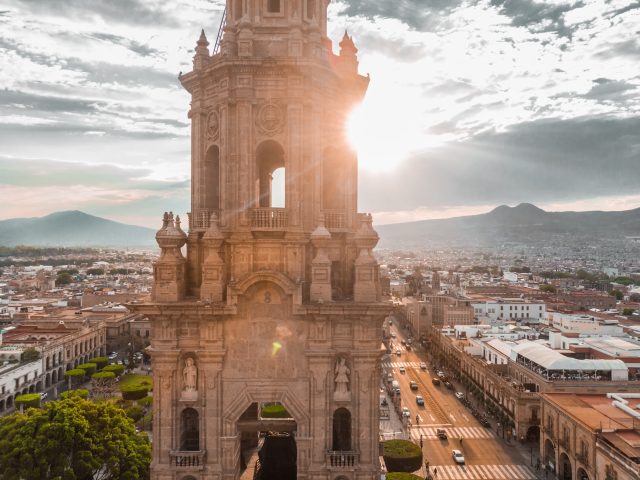Welcome to the land of vibrant culture and captivating history – Mexico. With its unique blend of Spanish colonial influence, modern architecture, and pre-Hispanic ruins, there is a seemingly endless list of iconic landmarks and remarkable architecture to explore in this exciting country. From grandiose cathedrals to the mysterious ancient cities scattered throughout the countryside, Mexico has something for everyone.
Mexico’s Landmarks
Mexico has a rich history and culture, and its landmarks reflect this diversity. One of the most famous landmarks is Chichen Itza, an ancient Mayan city on the Yucatan Peninsula. The pyramid-like structure of El Castillo dominates the skyline and is considered one of the New Seven Wonders of the World. Another notable landmark is Teotihuacan, a pre-Columbian Mesoamerican city near Mexico City. It features the iconic Pyramid of the Sun and the Pyramid of the Moon, built by the Aztecs.
The historic center of Mexico City is also a UNESCO World Heritage Site that features many landmarks, including the Cathedral of Mexico City, the National Palace, and the Palace of Fine Arts. Other landmarks include the Palenque Archaeological Site, the Marieta Islands, and the Cabo San Lucas Arch. Each landmark is a testament to Mexico’s rich history and cultural heritage, making it a popular destination for travelers worldwide.
Pre-Columbian Architecture

Mexico’s pre-Columbian architecture is a rich testament to the advanced civilizations that thrived in the region before the arrival of Europeans. The Aztecs, Mayans, and other pre-Columbian societies constructed impressive structures using advanced engineering and construction techniques, including pyramids, temples, and palaces.
One of the most iconic examples of pre-Columbian architecture is the Pyramid of the Sun in Teotihuacan, which dates back to the 2nd century CE. It was constructed using millions of hand-cut stones, and its base measures over 700 feet on each side. The Maya civilization also left behind impressive architecture, such as the towering structures in Chichen Itza, including the Temple of Kukulcan, which is a 98-foot-tall pyramid.
Pre-Columbian architecture often incorporated symbolism and religious iconography, with intricate carvings and murals adorning the structures. The ruins of Palenque, for example, feature intricate carvings and murals depicting mythological creatures and religious scenes. The Aztecs, on the other hand, built temples and palaces that incorporated symbols of their gods, such as the Templo Mayor in Mexico City.
Many of these pre-Columbian structures still stand today, and they continue to inspire awe and wonder in visitors from around the world. They are a testament to the remarkable engineering and architectural achievements of the pre-Columbian societies of Mexico and serve as an important reminder of the region’s rich cultural heritage.
Colonial Architecture
Colonial architecture in Mexico refers to the buildings constructed during the period of Spanish colonial rule, from the early 16th century until the early 19th century. During this time, Spanish architects and builders brought their own styles and techniques to Mexico. They also incorporated local materials and indigenous building traditions, creating a unique fusion of European and indigenous styles.
The most notable example of colonial architecture in Mexico is found in the historic center of Mexico City. The area is home to numerous cathedrals, palaces, and civic buildings that date back to the 16th and 17th centuries. One of the most impressive examples of colonial architecture is the Mexico City Metropolitan Cathedral, built between 1573 and 1813. It is the largest cathedral in the Americas and features a blend of Gothic, Baroque, and neoclassical architectural styles.
Other examples of colonial architecture in Mexico are Puebla and Oaxaca. Puebla’s historic center boasts some of the finest examples of colonial architecture in Mexico, including the Puebla Cathedral, completed in 1649. Oaxaca’s colonial architecture is characterized by its elaborate stonework and ornate facades, seen in buildings such as the Santo Domingo de Guzman Church.
Many of these colonial buildings have been designated as UNESCO World Heritage Sites, and efforts have been made to preserve and restore them. The fusion of European and indigenous styles in colonial architecture has made it an important part of Mexico’s cultural heritage. These historic buildings continue to inspire and amaze visitors from around the world.
Modern Architecture
Modern architecture in Mexico refers to the styles and trends that emerged after the country’s independence from Spain in 1821. During the 20th century, Mexican architects began experimenting with new materials, techniques, and aesthetics, resulting in a diverse array of modern buildings reflecting the country’s cultural identity and social context.
One of the most influential architects of modern Mexico was Luis Barragán, known for his use of bold colors, light, and geometry in his designs. His most famous works include the Casa Estudio Luis Barragán and the Chapel of the Capuchinas in Mexico City, which features Mexican and modernist aesthetics.
Another significant figure in modern Mexican architecture was Mario Pani, known for his innovative high-rise designs. He is best known for his Conjunto Habitacional Nonoalco-Tlatelolco, a sprawling residential complex in Mexico City with towering concrete towers.
In recent years, there has been a resurgence of interest in modern Mexican architecture, with many architects and designers embracing the country’s cultural heritage while also experimenting with new forms, materials, and technologies. Examples of recent modern architecture in Mexico include the Soumaya Museum, a curvaceous, aluminum-clad building designed by Fernando Romero, and the Vasconcelos Library in Mexico City, a contemporary take on a traditional library design that features a striking, multi-colored glass facade.
Overall, modern architecture in Mexico reflects the country’s unique cultural heritage and the creativity and innovation of its architects. These buildings continue to inspire and captivate visitors with striking designs and bold aesthetic statements.
Exploring the Landmarks
Exploring Mexico’s Iconic Landmarks and Architecture explores the country’s most recognizable architectural achievements. This article looks at some of Mexico’s best landmarks, from ancient Mayan ruins to iconic colonial-style buildings. From metropolitan cities like Mexico City to small villages dotted along the coastlines, each landmark offers its unique perspective on Mexican history and culture.
Mexico is home to some of the world’s oldest ruins and most awe-inspiring architecture. From palatial Aztec temples in Teotihuacan to secluded beachside sanctuaries in Tulum, exploring these landmarks allows us to experience how different civilizations have left their mark on Mexican culture throughout history. Whether you’re looking for outdoor adventure or cultural immersion, visiting these iconic sites will give you a deeper understanding of what makes Mexico special.
Cultural Significance
The cultural significance of architecture in Mexico cannot be overstated. Architecture is a tangible representation of a society’s values, beliefs, and cultural identity, and in Mexico, it reflects the country’s rich and complex history, as well as its artistic and architectural traditions.
Mexico’s architectural heritage reflects the country’s pre-Columbian and colonial past, as well as its modern aspirations. Pre-Columbian architecture, for example, includes the pyramids and temples that served as religious and ceremonial centers for the Aztecs and Maya and are adorned with intricate carvings and murals. Similarly, colonial architecture, with its blend of European and indigenous styles, reflects the complex social and cultural dynamics that shaped Mexico during the colonial period.
In addition to reflecting Mexico’s cultural history, architecture is an important medium for cultural expression and artistic innovation. Mexican architects and designers have always been at the forefront of experimenting with new materials, technologies, and aesthetics, resulting in bold, striking, and unique modern buildings.
Moreover, architecture in Mexico plays a significant role in the country’s cultural life, serving as important community spaces, places of worship, and centers of learning. These buildings have played a vital role in shaping Mexico’s social, cultural, and political landscape and continue to be a source of inspiration and pride for the country.
In conclusion, the cultural significance of architecture in Mexico is multifaceted and complex, reflecting the country’s rich cultural heritage, artistic traditions, and aspirations for the future. Architecture serves as a powerful medium for cultural expression, social and political change, and creative innovation and is an important part of Mexico’s cultural identity.
Conclusion
Mexico has a long, rich history visible in its iconic landmarks and architecture. From the ancient ruins of Chichen Itza to the modern skyscrapers of Mexico City, it’s clear that Mexican culture has been shaped by its people for many centuries.
Ultimately, we can see that despite its turbulent history and periods of political unrest, Mexico remains a vibrant nation with an incredible depth of architectural beauty. From colonial-era churches to contemporary art galleries, there is something remarkable to admire at every turn in this majestic land. As more visitors explore Mexico’s iconic landmarks and architecture each year, they are reminded why this country continues to be an enduring symbol of strength and perseverance around the globe.






























